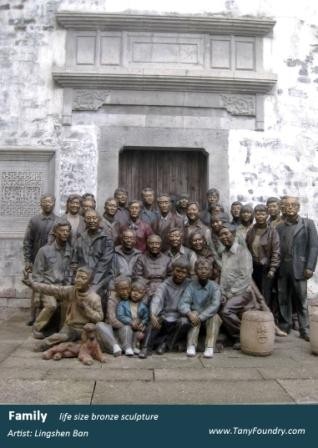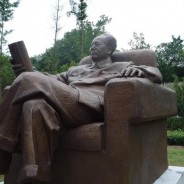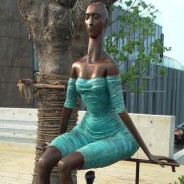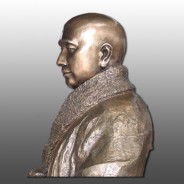5 Tips on Saving Budget on Sculpture Casting
In the down economy, it is important for sculptors to keep the cost of foundry service within the budget. With decades years’s experience on working in art casting. Tany Foundry would like to give some tips on how to save cost on foundry service. Choosing an affordable sculpture foundry The cost of sculpture casting service varies dramatically. One of the reason is the cost of labor and the technique they use. The cost difference is as much as twice or three times, depending on the size of your work. We suggest you to choose a foundry with Lost wax casting capacity when you have small or medium size works. Sand casting capacity when your have monumental bronze or aluminum sculpture to make. Sand casting can shorten the mold making process therefore reduce the related cost. However, it is not fitting for those sculpture with high details. You can seek local foundry with sand casting capacity ( there are not many in the US) or look for a foundry overseas. It makes sense if using an oversea foundry can help you save cost significantly. Choosing from a acceptable material for your project There are several options of material for your sculptures. Bronze : most commonly used metal for sculpture. You can do different patina on it. Also, it is one of the most expensive among metal casting. Brass: lower bronze percentage than bronze and cheaper than bronze. Patina options are also less then bronze. However, if you plan to do painting on the metal instead of patina, there is few difference between bronze and brass. Aluminum: lighter and cheaper than bronze. It is an economical material and useful when your budget is limited. Please note unlike bronze, it is difficult to do patina on aluminum. Usually people do painting on aluminum. Stainless steel: it’s not so often used in art casting. Also, it is even more expensive than bronze. Stainless steel is more used in sculpture fabrication than casting. Making mold and wax work yourself It can save your money from foundry service if you are able to make mold yourself. The charge of mold making varies among foundries, some takes up to 30% or higher of the total bronze casting cost. Therefore, making mold can help you a portion of the total cost. From our experience, it costs much less in Asia foundry like Thailand or China. Enlarge Sculpture with CNC milling instead of by Hand CNC milling is more and more used in sculpture enlargement. Though it still requires for some touch up work on finishing, it can save your time and money significantly. One thing worth noting is that you need to pay more attention on your Maquette because any imperfection will become significant after enlargement. Casting multiple pieces if possible. It can save you money if you can cast multiple pieces at the same time. Foundry can cast the multiple pieces at one turn and the marginal cost is small. If you have any tips on saving cost, please share with us. Thanks. ...
read moreBronze Sculpture Casting from 3D Printing
Tany Foundry is one of the first fine art foundries in China applying 3D printing to bronze sculpture casting. 3D Printing is very useful for making patterns directly from digital 3D mold. Recently we us RP for casting bronze sculptures for our old friend Tom , who is a talented sculptors very good at figurative sculpting. The sculptures are two 40 inches tall footballers. The artist sculpted the maquette and scan it with a 3D scanner, scale it up to the inch tall and send us the digital file. We print the sculpture out with Rapid Prototyping for bronze casting. Below is a detailed description of the whole process. This is the maquette of the sculpture, 12 inch tall. The maquette is to be scanned by a 3d scanner. The artist scan the Maquette with a 3D scanner and generate the 3D mold of the sculpture. There are many formats available for RP printing. The most often used is STL and STP. Besides 3D scanning, you can also use 3D software to create digital mould. The most commonly use 3D software is Rhino, Zbrush and Maya. After receiving the digital file from artist, we need to make necessary touch up on the work since there are always some piece missing during the scanning process. After refinement of the 3D mold, we print out the sculpture. We make sure all the textured details of the sculpture are well kept. The printed pieces require our artisan to remove the imperfection and smooth its surface. To do that, we use very fine grain sand paper to sand the piece. The finished work is ready for making silicone rubber mold and wax work. We make silicone rubber mold and the wax work ( for lost wax casting). We pay great attention to the make sure all the details of the wax is in perfect condition. We use lost wax casting to cast bronze sculpture. After the bronze castings come out, we do the metal chase and weld pieces together, check out all the welding seam and smooth them. Bronze sculpture casting has been Tany’s core business and we have a team of very skillful artisans to handle this. After chasing work, we do patina on the bronze casting and seal wax. According to the artist’s needs, we use dark brown for patina and the work is completed and they look really nice. If you have any question about the technical process of Rapid Prototyping ,bronze sculpture casting or need an estimate for making your own work, please contact us. ...
read morePubic art Project: steel rebar fabrication Wall
Case Study of Rebar Fabrication Wall Project Description: Rebar Fabrication Wall Dimension: 40 feet x 13 feet Material: Deformed steel bar Production: Fabrication This is a art fabrication project for a creative industry park. It is to be placed at the entrance of the park. The entire rebar fabrication measures 40 feet long and 13 feet tall. It is made up of short sections of rebar. Tany Sculpture has over 30 years experience as sculpture fabricator in China and this is a very interesting project for us to do. First we print out a draft of the fabrication wall, lay it out on ground. Then we cut rebar to the length as the drawing specifies. From the drawing you can see there are thousands of them. Our next step is welding rebars pieces by piece according to the draft. This is labor intense work, requiring patience and skill. We focus accuracy and strength of the welding. Below are some pictures on progress. Artist sent us the drawing of the work as a guide for us to fabricate. The whole piece is made up of numerous short steel rebar. Steel rebar are weaving to a large net like structure. We print out the patterns on a large draft on ground as a guide. All reabr are cut into short pieces first and then welded according to the drawing. The whole piece is erected for adjustment. The finished work. Those colorful characters are stainless steel fabrication. If you have any question about art fabrication or custom metal fabrication. Feel free to contact us. ...
read moreTips on Packing and Shipping Sculptures Safely
Nowadays, more and more sculptors and public artists need to ship their works to place far away for exhibition or foundry for metal casting. It is important to take actions to make sure the sculptures arrive at destination safely. Here are some tips we employ. – For small sized work, a strong corrugated carton or solid crafted wood crating is very helpful to protect the sculpture inside. However, wood without fumigation may not be allowed to enter into another country especially Europe, North America and Australia. Therefore, make sure the wood is fumigated or only use plywood, which is a multiple layer structured man made wood. Select the thickness of the wood carefully according to the weight of your sculpture. To make unpacking process easier for the recipient, use stainless steel bolts and nuts instead of nails to fix the cover of crating. Corrugated carton is more suitable for smaller sized work and it works quite well on protection. The more layer corrugated paper, the strong it is. – Outer packing is only the basic protection for sculpture from outside damage to the sculpture. There is strong vibration during delivery, especially shipping by sea. To avoid damage of vibration, make sure to stuff crating or cartoon inside with soft material. Bubble paper, foam and polystyrene are most commonly used. From our experience, polystyrene should be considered as one of the best stuffing material. It can be full all the empty space inside the crafting and absorb the energy of vibration effectively. Here are a case we pack a stainless steel sculpture with polished finish. Since the surface has to be protected carefully, we wrap the stainless steel pieces with very thick bubble paper and stuff the strong plywood crating with foam blocks. – Water drops may generate on the surface of sculpture during sea shipping duo to the severe temperature change, which could do harm to the metal. A good solution to this issue is to wrap a plastic paper or rubble paper around sculpture. Another good solution is place some drying agent in container or crating. The common drying agent is Calcium Chloride, which is cheap yet effective on absorbing water. Place the drying agent properly in crate or container, especially around the wall of container., where water gather. – For shipping large scale sculpture, we section the metal sculpture into several pieces. The way how it is sectioned is depending on the shape of the work. You have to make sure it can be placed into a standard container for sea shipping. Often, we will fabricate a very solid steel frame and pack the sculpture into the frame and tie them together with wire firmly. In you have any question on how to pack and ship your sculpture safely, feel free to drop us an...
read moreIn The Moon- 20 Feet Tall Bronze Monumental Sculpture
As a leading monument bronze foundry in China, Tany Foundry works with two famous Chinese artists Fang Xu and Jieyong Lau on casting a 20 feet tall bronze monumental sculpture: In The Moon. This bronze casting sculpture depicts a girl stretching out her hands under the moon with waves under her foot. The ideas originates from a legend of China and the sculpture is placed in a theming park in middle China. As a leading bronze sculpture foundry in China, we work with artists closely during whole process of the creation of this bronze sculpture. This is the sketch of this work. The composition of the sculpture is great with a nice combination of the body of girl and the curved moon. This is the Marquette of the work. Artist sculpted the girl with clay and we make a fiberglass pattern from it for easier review and keeping. We enlarged the work with clay. After the enlargement work is complete, we make plaster mold for bronze casting. Considering its size and shape, we use sand casting technique to cast bronze, which works best for large scale outdoor sculpture with more emphasis on its whole shape and outline instead of fine details. Technically, a large size bronze sculpture can be sectioned into several separate parts and cast with lost wax technique and then assembly them later. However, the shortcoming of applying lost wax technique on large scale sculpture is that distortion probably happens during the assembling process and this would cause damage to its beauty. By sand casting, we only need to sections the whole body into five parts: head and torso, limbs. This not only saves further assembling work but also make sure the sculpture looks nice. One of the difficulties of the sculpture is design of its armature. Duo the structure of the moon, we have to guarantee the weight of the moon distributed on to the bronze base evenly. Therefore, we weld very solid stainless steel armatures inside for supporting the whole sculpture. Here we are assembling and installing the whole sculpture. Here are some photos of the sculpture In The Moon from different perspective. If you have any question or need a quote from a art foundry. Please contact us. We look forward to your...
read moreGold Gilt Bronze Sculpture
Gold gilding is a traditional decorative technique for applying gold leaf to solid surface such as metal, wood, stone. Gold leaf is extremely thin. The average thickness is around 2.4 μ ,whose thickness is only one tens of diameter of a hair. Sculptors worldwide have been long applying gold gilding onto their sculptures. Egypt is one of the earliest to use this technique. In ancient China, sculptors gold gild on bronze sculpture such as Buddha. This made craftsman master the technique quite well because gold gilding is a way to expressing their respect toward Buddha. Japan is another country which master this technique fluently. Tany Foundry, as a leading sculpture foundry in China, has been casting bronze and gold gilding for 30 years. Here are some of benefits of applying gold gilding onto sculptures. Gold, with its luster, makes the sculpture looks really beautiful. Below is the gold gilt sunflowers and lotus Tany Foundrymade for one of the top Chinese artist Xu Jiang.The sculptures are bronze casting and we apply gold leaves onto every single sunflowers, lotus and stone. With proper finish treatment, gold gilding is highly anti-oxidation, which means the sculpture can keep its luster over years.Here are some of gold gilt bronze athlete sculptures Tany Foundry made over 10 years ago. They look just like brand new now even though they are not maintenance regularly. To make the most from gold gilding, we have some tips for sculptors planning to use this technique. If funding allows, use 22K or 24K gold leaf instead of those with lower gold percentage. This could make the gilt sculpture last its luster much longer. Hire skillful gilding craftsman. They can save you a lot of budget. Experienced craftsman is able to make best use of each gold leaf without wasting. Also, they can make a big difference on the final finishing effect. Apply a clear coating after the gilding is finished. The coating works as a protective layer on the gold finish. Feel free to let us know if you have any technical question about gild gilding. Please click...
read moreDream Boat: Copper Sculpture Fabrication
Bronze and copper is often used for sculpture fabrication. Tany Foundry has a team of professional and very experienced artisan. Copper, which is of great extension ability under high temperature, is an excellent material for art fabrication. Before the plastic is invented, copper is one of the most used materials for making everyday utensil: bowl, table, etc. Now plastic and other new material take place of copper but copper successfully find its way into modern art and ornament purpose. Compared with bronze casting, it’s relatively easier to explain how copper fabrication works. To put it simple, fabrication is forming the metal into the desired shape with multiple steps: cutting, welding, bending, finishing, polishing, assembling and other methods. Here is a case of Tany Foundry copper fabrication sculpture. This sculpture is called dream boat which is fabricated with copper, 45 feet long. Overall, the sculpture is made up of two parts, the wave like copper tubes and the curved deck. Here are basic steps how we fabricate it. Fabricate an armature with galvanized steel, which works as a skeleton and support of the whole sculpture. We have to make sure the armature is very strong because whole sculpture weights on it. Prepare copper sheets of 2MM thick and weld them together to the curve required in the drawing and weld them with the armature. Bending copper tubes an welding tubes together to the desired length. This is a very important step in the whole process because the tube shape wave is the major visual feature of this work. The patterns of the wave are carefully designed. We lay the drawing on grounds and shape bronze tubes rigidly following the pattern. Mount the bent copper tubes onto the finished frame. Fix individual bronze tubes together welding and bolts. Finishing and Patina. Here are some pictures of this project. Please let me know if you have any question about the fabrication process. Please click...
read moreBronze Cast Sculpture in Varied Patinas
Bronze has been the most often used material for casting sculpture. This is because of the bronze property which could flow and fill all cavity of the mold and therefore reproduce artist’s original work. The so called bronze is actually not pure copper, instead it’s a alloy with a combination of copper and other elements. Silicone, tin and zinc are common element used for forming alloy. Another benefit of using bronze for casting sculpture is its ability to make varied patina. Bronze can react with other chemical easily to represent varies color. The commonly used technique for patina is torching approach and immersion approach, depending on the size of the sculpture. The Torching approach is suitable for middle or large scale sculpture. The first step is to clean the bronze body completely, remove any grease. This is the key step which would make a difference on the final effect. The grease remains would prevent the bronze reacting with the chemicals and leave inconsistent color on sculpture. Then brush and polish the bronze surface. This purpose of this step is not only clean those tiny in and out of the sculpture but also make chemical work with bronze more easily. After that, heat the bronze with torch up, spraying chemical solution onto the bronze. The most used chemical are cupric sulphate, ammonia compounds, etc. The craftsman torch the bronze surface sprayed with chemical solution and make sure the chemical reaction happens. Usually the process would be done a couple of times. There are multiple options for patina. Basically, there are four major color group:Brown; red, green, black. There are quite a few gradual alternatives and combinations of these colors. After reaching the desired patina, the craftsman would brush a thin lay of wax or apply coating onto the bronze sculpture. This could protect the bronze patina last longer. Below are a few of bronze sculptures we patina. If you have any technical question about patina, feel free to contact us....
read moreA Case Study of Stainless Steel Fabrication Public Art
In 2010, to celebrate Shanghai World Expo, we worked with artist Huaibing Guan to fabricate a stainless steel public artwork, called Travel in Time. This works measures 88 feet long and 13 feet wide. It’s fabricated with stainless steel by hand. This is a maze like structure with paths inside. People can go through the paths to experience of traveling in time. The whole maze are made up of around 30 separate pieces. The components of this works are square stainless tubes. We print out the drawing and bend, weld stainless tubes according to drawing. Stainless steel fabrication is a laborious works which requires the metal worker with rich experience and knowledge. One of the difficulty of this job is to make sure the separates pieces can fit with each other for installation. After the frame is complicated, we grind those welds to make sure it’s smooth. The final step is painting. According to the artist, we apply white painting onto stainless steel. After completion, we transport the works in Shanghai square and install it. If you have any question on this project or technical question about your own project, please email us....
read moreTips to Choose a Fine Art Foundry to Work With
After you spend tons of hours creating a sculpture, the next biggest consideration is to choose an reliable art foundry to cast your works. There are quite a few foundries in Europe, North America. So, how to target an ideal one? One of the best practices is hearing that your friends say. The foundry your friend recommend must get proven his own experience and therefore trustworthy. Another good way is via internet. There are tons of information these days on net: traditional website, social network service such as Facebook, Twitter, etc. One of the biggest advantages of social network is that you can communicate with the people from that foundry before you place an order. Usually, there are rich information you can learn from that foundry’s profile page: you can talk with the foundry about their past work, their casting methods, equipment, price, etc. The more you talk with him, the deeper you know about him. There are several factors you’d better take into consideration: 1. Quality. This is one of the most important factors. It’s easy to test a foundry’s quality by letting them do a small scale sculpture such as a life size bust. Then you can watch closely the casting’s finish, patination and other factors. The test casting is a good method to provide you with information for your further selection. 2. Cost. There are many foundries to choose from and you can compare their offers based their work quality into consideration. Nobody wants their carefully sculpted work riddled with imperfection or other poor finish and patination. You can make a list with potential foundries on it. Those foundries should be able to offer you quality work at a reasonable price. 3. Equipment and Technical process. It’s important to understand that small scale and large scale sculptures required different equipments and process. For small sculpture, foundry often use lost wax technique to cast and for large scale sculpture, they use sand casting. Most of small foundries only have lost wax casting equipment while those medium and large foundries have sand casting equipments. 4. Distance. People tend to work with short distance art foundry because that way they can communicate with the foundry easily and it’s easier for them to keep track of the process. The con of choosing based on distance is that the nearest foundry doesn’t always offer best quality at best price. With the developing logistics and long distance videoing technique ( transfer the picture or video of the process to sculptors lively), lots of sculptors can now work with a distant foundry closely with everything under control. The above are some tips for selecting an ideal art foundry for you. Your ideas or comments are appreciated. If you have any question or comment on how to select an art foundry, please click here....
read more




